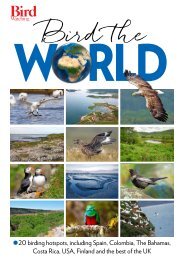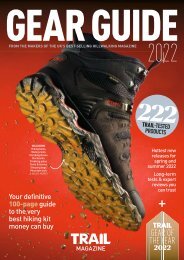You also want an ePaper? Increase the reach of your titles
YUMPU automatically turns print PDFs into web optimized ePapers that Google loves.
DISCOVER The Lyke Wake Walk<br />
Blue Peter featured it twice, and it became the most<br />
popular charity walk in the country. Witches<br />
and Dirgers could meet at formal ‘wakes’ where<br />
they would sing The Lyke Wake Dirge and hear<br />
dissertations given by those seeking higher<br />
rankings based on their accomplishments –<br />
which soon became astonishing. And then it<br />
all came to a juddering halt. Tell you more in a bit.<br />
11.48am The Lion Inn, Blakey Ridge (19 miles)<br />
The one single pub passed on the route. And<br />
somehow, I’m not stopping. But a mile further on,<br />
while moving in a vast and slightly annoying arc<br />
around the head of Rosedale, I pause to celebrate<br />
being 20 miles into the Lyke Wake. Half way.<br />
I mark the moment by applying Blis-Toes.<br />
1pm Fat Betty (22 miles)<br />
Fat Betty is a distinctive stone, half painted white.<br />
Shortly after passing her, I part ways from the<br />
Coast to Coast. Now it’s just me and the Lyke Wake,<br />
and together we set out across what will be the<br />
predominant terrain for the rest of the route: open<br />
moorland. The junction is marked by the first Lyke<br />
Wake waymarker on the route, a stone that points<br />
into seemingly trackless bog. This is, by the<br />
designation of the offcial guide, ‘the boggy bit’:<br />
three miles of squelch, ditch and hag, all the way to<br />
Shunner How. It’s not too bad at this point in time.<br />
After prolonged rain it becomes some kind of hell.<br />
I’ve seen the photos.<br />
3pm Blue Man i’ th’ Moss (26½ miles)<br />
Easily the most intriguingly named but anticlimactic<br />
moment of the walk: a small, blue-painted<br />
stick man on yet another standing stone. Still open<br />
moorland, but less boggy, and the path is always<br />
roughly visible, even if not much more than a line<br />
in the heather at times.<br />
So let’s get back to the story. By the late Seventies,<br />
the Lyke Wake had become a monster. The huge<br />
numbers caused erosion, litter and even moorland<br />
fires from discarded cigarettes. So in 1982, the<br />
national park authority took drastic action: asking<br />
Ordnance Survey to remove it from maps, turning<br />
down all TV requests to film on the route, and<br />
pleading with charities not to offer it as a sponsored<br />
walk. It worked; numbers plummeted almost<br />
instantly, and the Lyke Wake slowly sank into<br />
something like obscurity.<br />
More in a bit – right now I’ve got to watch out<br />
for the Hogwarts Express.<br />
5.18pm The North Yorkshire Moors<br />
Railway (33 miles)<br />
A little over twelve hours in, I’m crossing the<br />
NYMR, on its way from Pickering to Whitby.<br />
Catch it at the right time and you might catch sight<br />
of a steam locomotive arcing gracefully through<br />
the valley and right past your toes. I didn’t.<br />
6.13pm Lilla Cross (35½ miles)<br />
Past Eller Beck, past the gloomy pyramid of RAF<br />
Fylingdales (the first place that will know if we’re<br />
ever under nuclear attack) and on to this fine ancient<br />
cross. I’m scenting the<br />
end. With my newfound<br />
sense of scale, 4½ miles<br />
will surely feel like less.<br />
6.58pm Jugger Howe<br />
Beck (38 miles)<br />
Nope. Trudging now, and<br />
the drop-climb into and<br />
out of Jugger Howe Beck<br />
was a bit of a £*7%.<br />
So let’s finish this.<br />
The Lyke Wake<br />
continued in its quieter<br />
form into the Nineties. But after Bill Cowley passed<br />
away in 1994, things started to get weird. Different<br />
factions within the fanbase argued over the future<br />
of the club, culminating in an extraordinary day:<br />
October 1st, 2005; the 50th anniversary of Cowley’s<br />
first crossing.<br />
At a wake in Ravenscar, the original Lyke Wake<br />
Club was formally disbanded, its leaders feeling<br />
the organisation had run its course. At another,<br />
in Osmotherley, a breakaway faction launched<br />
the New Lyke Wake Club, feeling that there should<br />
still be an active home for fans of the walk.<br />
Both factions continue today. The original club<br />
maintains the lykewakewalk.co.uk website and still<br />
issues merchandise. The New Club is far more<br />
active, producing a regularly updated guidebook,<br />
recording crossings, holding wakes, and selling<br />
subtly different merch at lykewake.org<br />
It is an astonishing tale, told in more florid detail<br />
in Mike Parker’s wonderful book Wild Rover. And it<br />
explains why a walk that was once a staple of<br />
Seventies TV has now become a whispered secret.<br />
I meet plenty of walkers during my crossing, but all<br />
are either just out for the day, or doing the Cleveland<br />
Way or Coast to Coast. Several look blank when<br />
I mention the Lyke Wake Walk. Two mishear it<br />
as the Lightweight Walk – a source of some irony,<br />
given the 50-litre rucksack on my back.<br />
7.26pm The Coast Road (39 miles)<br />
The end – a radio mast – is literally in sight, and<br />
I will soon breach 40 miles. Footsore and pretty<br />
tired, but nearly there now, eh?<br />
7.45pm Stony Marl Moor (40½ miles)<br />
WHAT IS GOING ON? Everything said the Lyke<br />
Wake was 40 miles. But my GPS says I’ve smashed<br />
through the big 4-0 and the mast is still way ahead<br />
of me. AND IT’S ALL UPHILL.<br />
7.52pm Beacon Howes (41 miles)<br />
’Tis done. 14 hours, 54 minutes and 28 seconds<br />
after I left the first marker stone, I’m at the second.<br />
It’s an inauspicious end: stone, mast, layby, grey<br />
gloaming. It’s not even ‘at’ Ravenscar or on the<br />
coast – the village and its cliffs are half a mile<br />
further on (the finish line used to be at the Raven<br />
Hall Hotel in Ravenscar, but was moved shy of the<br />
village by local request). I’m not sure why my watch<br />
thinks I’ve gone an extra mile; I never deviated<br />
from the route. So I either mistrust the offcial<br />
u<br />
A RARE BEAST<br />
Aside from the<br />
etched stones at<br />
either end, there<br />
are only two<br />
waymarkers along<br />
the 40-mile route.<br />
This is one.<br />
WHY SO<br />
BLUE, MAN?<br />
The standing stone<br />
Blue Man i’ th’Moss<br />
(opposte page, top)<br />
is the only named<br />
object on the map<br />
for several miles.<br />
Nice chap, good<br />
with the banter.<br />
Brian Smailes,<br />
who passed away in<br />
November last year, was<br />
a legend of the Lyke<br />
Wake. Chairman of the<br />
New Club and author of<br />
all four editions of its<br />
offcial Lyke Wake Walk<br />
Guide, he also held the<br />
records for the fastest<br />
continuous four and<br />
five crossings. Says<br />
club secretary Gerry<br />
Orchard: “Many<br />
a person having<br />
completed the walk will<br />
be grateful for Brian’s<br />
tireless efforts. He had<br />
a wonderful line in<br />
humour; correct and<br />
formal when required<br />
but with a wonderful<br />
mischievous streak too.”<br />
APRIL <strong>2021</strong> COUNTRY WALKING 49

















